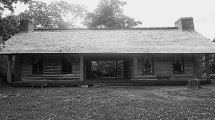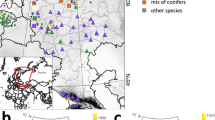Abstract
Throughout the Middle Ages forests in Flanders (northern Belgium) experienced a dramatic human influence. Forests were logged for wood supply and converted to arable land. The structure of the remaining forests was altered. This, combined with the tempering influence of the Atlantic climate, results in conditions that are suboptimal for dendrochronological research. Tree-ring series of Quercus robur and Q. petraea of timber from medieval archaeological sites are often short, show abrupt growth-rate variations and are complacent. The question arises whether tree-ring series of this type are potential records of past management and whether they could constitute the basis of a reference chronology for archaeological dating. During six archaeological excavations in and around the medieval town of Ypres, cross-sections were collected. The tree-ring series could be dated back to the 12th–14th centuries, using reference chronologies from surrounding regions. The growth pattern of the short sequences displays a high similarity to tree-ring series from modern coppice. For the first time, it has been confirmed that dendrochronological analysis in Flanders is possible and can provide valuable information on medieval forest use and structure.






Similar content being viewed by others
References
Baillie MGL (1995) A slice through time. Dendrochronology and precision dating. Batsford Ltd, London
Baillie MGL, Pilcher JR (1973) A simple crossdating program for tree-ring research. Tree-Ring Bull 33:7–14
Bechmann R (1990) Trees and Man: the forest in the Middle Ages (translated by K Dunham). Paragon House, New York
Becker B (1981) Fällungsdaten römischer Bauhölzer, anhand einer 2350 jährigen süddeutschen Eichenjahrringchronologie. Fundberichte aus Baden-Württemberg 6:369–386
Bernard V (1998) L'homme, le bois et la forêt dans la France du Nord entre le Mésolithique et le Haut Moyen-Age. BAR International Series 733, Oxford
Billamboz A (1996) Tree rings and pile-dwellings in Southern Germany: following in the footsteps of Bruno Huber. In: Dean JS, Meko DM, Swetnam TW (eds) Tree rings, Environment and Humanity. Proceedings of the International Conference, Tucson, Arizona, 17–21 May 1994. University of Arizona, Tucson, pp 471–483
Billamboz A (2003) Tree rings and wetland occupation in southwest Germany between 2000 and 500 BC: dendroarchaeology beyond dating in tribute to FH Schweingruber. Tree-Ring Res 59:37–49
Bridge MC (1988) The dendrochronological dating of buildings in southern England. Med Archaeol 32:166–174
Bridge MC, Hibbert FA, Rackham O (1986) Effects of coppicing on the growth of oak timbers in the Bradfield woods, Suffolk. J Ecol 74:1095–1102
Briffa KR, Jones PD (1990) Basic chronology statistics and assessment. In: Cook ER, Kairiukstis LA (eds) Methods of dendrochronology: applications in the environmental sciences. Kluwer, Dordrecht, pp 137–152
Buis J (1985) Historia forestis: nederlands bosgeschiedenis. HES Uitgevers BV, Utrecht
Cook ER (1990) A conceptual linear aggregate model for tree rings. In: Cook ER, Kairiukstis LA (eds) Methods of dendrochronology: applications in the environmental sciences. Kluwer, Dordrecht, pp 98–104
Cook ER, Briffa KR, Shiyatov S, Mazepa V (1990) Tree-ring standardization and growth-trend estimation. In: Cook ER, Kairiukstis LA (eds) Methods of Dendrochronology: Applications in the environmental sciences. Kluwer, Dordrecht, pp 104–123
Eckstein D, Baillie MGL, Egger H (1984) Dendrochronological dating. Handbooks for archaeologists 55. European Science Foundation, Strasbourg, France
Eckstein D, Bauch J (1969) Beitrag zur Rationalisierung eines dendrochronologischen Verfahrens und zur Analyse seiner Aussagesicherheit. Forstwissenschaftliches Centralblatt 88:230–250
Fritts HC (1976) Tree-rings and climate. Academic, London
Haneca K, Wazny T, Van Acker J, Beeckman H (2005) Provenancing Baltic timber from art historical objects: success and limitations. J Archaeol Sci 32:261–271
Hillam J, Morgan RA, Tyers I (1987) Sapwood estimates and the dating of short ring sequences. BAR Int Ser 333:165–185
Hoffsummer P (1995) Les charpentes de toiture en Wallonie, typologie et dendrochronologie, (XIe-XIXe siècle). Etudes et documents, Monuments et sites, 1. Ministère de le Région wallonne, Division du patrimoine, Namur
Hollstein E (1965) Jahrringchronologische Datierung von Eichenhölzern ohne Waldkante. Bonner Jahrbücher 165:12–27
Hollstein E (1980) Mitteleuropäische Eichenchronologie. Trierer dendrochronologische Forschungen zur Archäologie und Kunstgeschichte, Trier Grabungen und Forschungen 11. Phillipp von Zabern, Mainz
Houbrechts D, Pieters M (1996) Tonnen uit Raversijde (Oostende, prov. West-Vlaanderen): een goed gedateerd verhaal over water- en andere putten. Archeologie in Vlaanderen 5:225–261
Jansma E (1995) RememberRINGs. The development and application of local and regional tree-ring chronologies of oak for the purposes of archaeological and historical research in the Netherlands. Nederlandse Archeologische Rapporten 19. ROB, Amersfoort
Kuniholm PI (2001) Dendrochronology and other applications of tree-ring studies in archaeology. In: Brothwell DR, Pollard AM (eds) Handbook of archaeological sciences. Wiley, pp 35–46
Leuschner HH, Spurk M, Baillie M, Jansma E (2000) Stand dynamics of prehistoric oak forests derived from dendrochronologically dated subfossil trunks from bog and riverine sediments in Europe. Geolines 11:118–121
Rackham O (2003) Ancient woodland: its history, vegetation and uses in England. Castlepoint Press, Dalbeattie
Rinn F (2003) TSAP-Win User Reference (version 0.53). RinnTech, Heidelberg
Tack G, van den Bremt P, Hermy M (1993) Bossen van Vlaanderen. Een historische ecologie. Davidsfonds, Leuven
Vera FWM (2000) Grazing ecology and forest history. CABI Publishing, Wallingford
Wigley TML, Briffa KR, Jones PD (1984) On the average value of correlated time series, with applications in dendroclimatology and hydrometeorology. J Clim Appl Meteorol 23:201–213
Acknowledgements
The authors owe their gratitude to M. De Wilde, A. Ervynck (Flemish Heritage Institute) and their co-workers on the field for providing the opportunity to analyse a rich collection of medieval oak from archaeological sites in Flanders. We are also grateful to C. Lavier (Laboratoire de Chrono-écologie, Besançon) for providing related tree-ring data. Furthermore, we would like to thank the dendro-laboratory in Hamburg (D. Eckstein, S. Wrobel and co-workers) for the opportunity to use their chronologies and for helping us with the sample preparation.
Author information
Authors and Affiliations
Corresponding author
Rights and permissions
About this article
Cite this article
Haneca, K., Boeren, I., Van Acker, J. et al. Dendrochronology in suboptimal conditions: tree rings from medieval oak from Flanders (Belgium) as dating tools and archives of past forest management. Veget Hist Archaeobot 15, 137–144 (2006). https://doi.org/10.1007/s00334-005-0022-x
Received:
Accepted:
Published:
Issue Date:
DOI: https://doi.org/10.1007/s00334-005-0022-x




